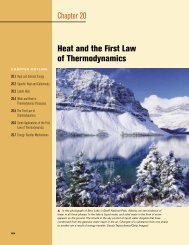15 • Oscillatory Motion - ECHSPhysics
15 • Oscillatory Motion - ECHSPhysics
15 • Oscillatory Motion - ECHSPhysics
Create successful ePaper yourself
Turn your PDF publications into a flip-book with our unique Google optimized e-Paper software.
The inverse of the period is called the frequency f of the motion. Whereas the period<br />
is the time interval per oscillation, the frequency represents the number of oscillations<br />
that the particle undergoes per unit time interval:<br />
(<strong>15</strong>.11)<br />
The units of f are cycles per second, or hertz (Hz). Rearranging Equation <strong>15</strong>.11 gives<br />
(<strong>15</strong>.12)<br />
We can use Equations <strong>15</strong>.9, <strong>15</strong>.10, and <strong>15</strong>.11 to express the period and frequency of<br />
the motion for the particle–spring system in terms of the characteristics m and k of the<br />
system as<br />
(<strong>15</strong>.13)<br />
(<strong>15</strong>.14)<br />
That is, the period and frequency depend only on the mass of the particle and the<br />
force constant of the spring, and not on the parameters of the motion, such as A or .<br />
As we might expect, the frequency is larger for a stiffer spring (larger value of k) and<br />
decreases with increasing mass of the particle.<br />
We can obtain the velocity and acceleration 2 of a particle undergoing simple harmonic<br />
motion from Equations <strong>15</strong>.7 and <strong>15</strong>.8:<br />
v dx<br />
dt<br />
f 1<br />
T<br />
T 2<br />
f 1<br />
T<br />
1<br />
<br />
2f 2<br />
2 √ m<br />
2 √ k<br />
A sin(t )<br />
a d 2 x<br />
dt 2 2 A cos(t )<br />
(<strong>15</strong>.<strong>15</strong>)<br />
(<strong>15</strong>.16)<br />
From Equation <strong>15</strong>.<strong>15</strong> we see that, because the sine and cosine functions oscillate<br />
between 1, the extreme values of the velocity v are A. Likewise, Equation <strong>15</strong>.16<br />
tells us that the extreme values of the acceleration a are 2 A. Therefore, the maximum<br />
values of the magnitudes of the velocity and acceleration are<br />
v max A √ k<br />
m A<br />
a max 2 A k<br />
m A<br />
(<strong>15</strong>.17)<br />
(<strong>15</strong>.18)<br />
Figure <strong>15</strong>.6a plots position versus time for an arbitrary value of the phase constant.<br />
The associated velocity–time and acceleration–time curves are illustrated in Figures<br />
<strong>15</strong>.6b and <strong>15</strong>.6c. They show that the phase of the velocity differs from the phase of the<br />
position by /2 rad, or 90°. That is, when x is a maximum or a minimum, the velocity<br />
is zero. Likewise, when x is zero, the speed is a maximum. Furthermore, note that the<br />
2 Because the motion of a simple harmonic oscillator takes place in one dimension, we will denote<br />
velocity as v and acceleration as a, with the direction indicated by a positive or negative sign, as in<br />
Chapter 2.<br />
2<br />
T<br />
k<br />
m<br />
SECTION <strong>15</strong>.2 <strong>•</strong> Mathematical Representation of Simple Harmonic <strong>Motion</strong> 457<br />
▲ PITFALL PREVENTION<br />
<strong>15</strong>.4 Two Kinds of<br />
Frequency<br />
We identify two kinds of frequency<br />
for a simple harmonic oscillator—f,<br />
called simply the frequency,<br />
is measured in hertz, and<br />
, the angular frequency, is measured<br />
in radians per second. Be<br />
sure that you are clear about<br />
which frequency is being discussed<br />
or requested in a given<br />
problem. Equations <strong>15</strong>.11 and<br />
<strong>15</strong>.12 show the relationship between<br />
the two frequencies.<br />
Period<br />
Frequency<br />
Velocity of an object in simple<br />
harmonic motion<br />
Acceleration of an object in<br />
simple harmonic motion<br />
Maximum magnitudes of speed<br />
and acceleration in simple<br />
harmonic motion



